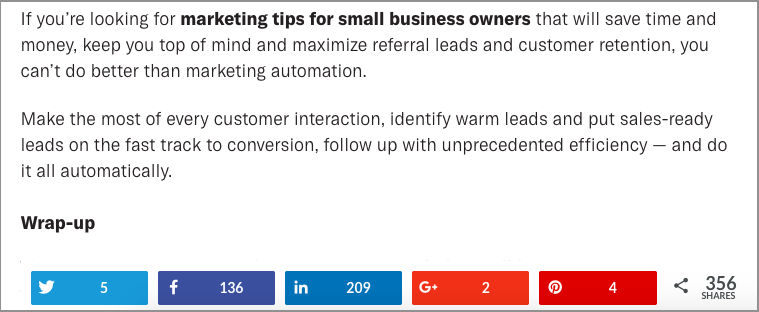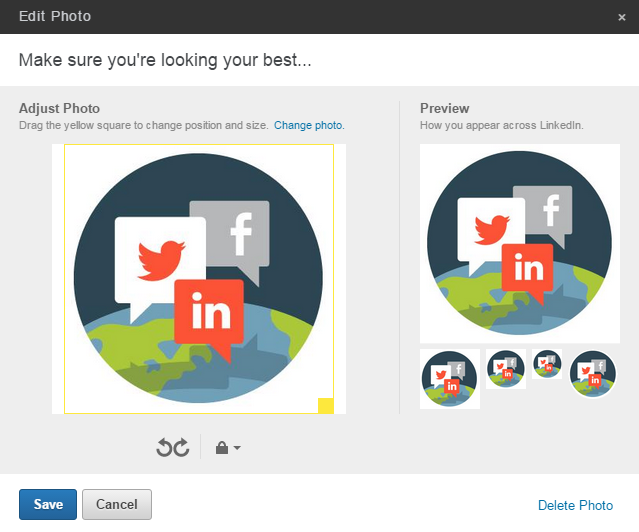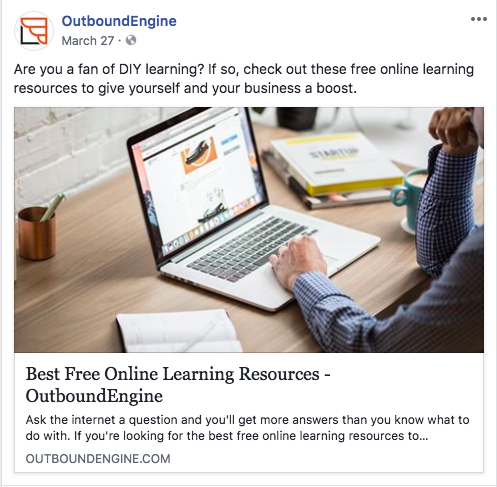Today’s small business owner isn’t intimidated by social media. How do we know? According to the 2015 Social Media Marketing Industry Report, 93 percent of small business owners reported using Facebook, 79 percent use Twitter and 71 percent use LinkedIn. But being present and accounted for isn’t exactly the same thing as growing a social media presence.
On the surface, it may look easy. Just share a few blurbs about the company and go on with your day. But in reality, social media growth requires time and effort, not to mention ongoing execution, monitoring, and strategic adjustment. That’s why so many businesses — large and small — turn to automation.
For those of you who are brave enough to handle it yourself, we’ve put together a helpful list of tips and best practices that can help you increase your social media presence.
1. Use Consistent Photos, Headshots, and Logos
Brand consistency across social media channels is essential. You want to be easily recognized, yet so many small business owners are content to leave up profiles with mismatched logos and photos, some of which are blurry and improperly sized.
This type of carelessness causes unnecessary confusion for your customers and can make you seem unprofessional. Instead of using whatever photos you have handy or simply taking the one-size-fits-all approach, take the time to create a consistent brand image across all networks and optimize your chosen photos according to each network’s specifications.
For example, here are the minimum profile size requirements (in pixels) for a few of the major social networks:
Let’s be honest. It’s not like you have to hire a professional photographer to get a good headshot these days. Using your smartphone and the basic editing tools provided by the networks, you can create and add appropriate images in a matter of minutes.
For example, LinkedIn’s photo tool lets you rotate, reposition and resize your images so that no important information is lost during cropping. It also provides a preview of what your photo will look like in various formats on the LinkedIn website.
Bonus Content: Snag a copy of our handy time-saving tool sheet.
2. Let the World Know You’re on Social Media
Getting found through organic search doesn’t happen overnight. You’ll need to build a following and expand your reach over time. The easiest and most cost-effective place to start is with friends, family, colleagues, and customers.
Remember, you’re not adding these contacts because you necessarily expect to make a sale. Nor are you adding them just to boost your numbers. You want to expand your reach and stay top of mind with as many people (preferably prospects) as possible. Why is this important?
- 85 percent of small businesses report their best source of new customers is word-of-mouth referrals.
- Recommendations from family and friends are trusted more than any other form of advertising by 92 percent of customers.
Word-of-mouth referrals and social media go hand in hand. Even if your friends and family aren’t actively promoting your business or making personal recommendations, they have effectively endorsed your business just by liking your page. That act alone helps expand your reach exponentially.
3. Create and Share Industry-Adjacent Content
It’s only natural that you should want to present yourself as an expert in your industry, but the content you create, curate and share can’t always revolve directly around your business. If all you do is spout thinly veiled advertisements, you’re going to lose followers.
Think of it this way: Social media is like a cocktail party. No one wants to get stuck listening to the guest who can’t stop talking about himself. But on social media, escape is easy. There’s no hesitation and no chance of hurt feelings. All you have to do is click “unfollow.”
Don’t drive your customers away by being a self-centered salesman. Instead, think about your audience. What can you provide to pique their interests or fulfill their needs? Valuable, industry-adjacent content can be a great way to stay top of mind without wearing out your welcome.
For example, Coca-Cola shared this post for National Cheeseburger Day. Judging by the number of likes and shares, I’d say quite a few people enjoy a Coke with their cheeseburger!

4. Create a Schedule and Post Content Regularly
One of the most common mistakes you’ll see with social media for small business is a lack of consistency in the posting schedule. This not only affects post visibility, but it can also make it hard to gain traction with search engines.
Maybe it’s the mindset that once you’ve posted, the content is on the wall for the duration, and there’s no hurry to follow up. But that line of thinking is flawed, as most people aren’t checking your profile page with any regularity. Instead, followers see your content as they scroll through their personal Facebook feeds.
But content moves fast, and the window of opportunity you have to make a connection is limited — and even more so if you’re not posting consistently. This is especially true on Facebook, where engagement plays a part in determining what content appears in a user’s news feed.
Creating a social media editorial calendar not only helps you keep posts consistent and timely, but it also gives you a chance to develop an overarching and integrated content strategy. You can map out your posting schedule, fill in business-related promotions and events, and brainstorm for industry-adjacent content ideas that will provide value to your readers.
It’s a good idea to monitor your progress from idea to execution to determine how long each post will take. Remember, you’re not only coming up with topics, but you’re doing the research, writing and editing the content and finding corresponding images. Keep in mind that this entire process can take a great deal of time.
Time is a luxury you can’t afford…or is it?
Download your copy of our Time-saving Tools Cheat Sheet.
5. Make the Most of Visual Content
Visual content is a big deal. In fact, 82 percent of marketers say images are an important to very important part of social media content optimization, and 52 percent say video content produces the best ROI.
Meanwhile, visual social networks are starting to rise through the ranks. Instagram has over 800 million monthly users, and Pinterest isn’t far behind with 100 million monthly users.
Images and video can be used in a variety of ways. For example, this video promotion from Taco Bell received over 66k views.
Videos could be used to record a quick how-to or promote a charitable cause, or you could ask followers to post videos of your products in action as a sort of testimonial.
Video and images can be used across all social channels, not just the “visual” networks, like Instagram, Pinterest, and Snapchat.
6. Cross Promote Content Across All Channels
Take advantage of every opportunity to cross promote your social media profiles. Linking profiles is a great start, and some networks will actually provide the social icons for you. You should also add icons to your website, links to your email signatures, and social info to your printed marketing materials.
Here at OutboundEngine, we make it easy for our blog readers to share content using a widget that allows our social icons to float to the top or bottom of our blog, even as you scroll.

Next, share content across platforms, but keep in mind that each social network has a distinct personality. What works on Instagram won’t work on LinkedIn, and what works on LinkedIn won’t necessarily work on Twitter. That’s not to say you can’t share the same content on all of these platforms; you just have to tailor the presentation to suit the network.
Take Twitter for example. A great headline on Facebook may get truncated by Twitter’s 140-character limit. Instead of losing vital information that could affect your click-through rate, consider presenting the content with a Twitter-friendly headline.
We recently published a blog post called “The Best Free Online Learning Resources for a Tight Budget.” You’ll notice that we introduced the post on Facebook by asking a question (and setting up a solution).
Bonus Tip: If you’re using multiple platforms to promote the same blog post or piece of premium content, create customized tracking URLs to measure engagement.
7. Don’t Be Afraid to Advertise
It’s natural to shy away from paid advertisements on social media, but paying to play isn’t always a bad thing. Social media platforms like Facebook and LinkedIn have access to more data than you can imagine, which makes it possible to run highly targeted, actionable campaigns that you just couldn’t run elsewhere.
Now you can go beyond location and demographic-based marketing and delve into the world of interest-based and behavioral targeting. You can target look-alike audiences or simply create an audience from your own list of contacts. Consider sponsoring posts on LinkedIn or check out a variety of advertising options on Facebook, where you can get started for as little as $5 a day.
8. Stay on Top of Trends With Twitter
Twitter provides bite-sized chunks of information, perfect for staying on top of breaking news, industry trends, local events and more. If your business is very much location-based, following local Twitter handles (aiming for at least 20) can be a great way to stay on top of what’s new in your community. Ideas include local celebrities, news anchors, businesses that you support, event calendars, newspapers and radio stations.
You can also pay attention and take advantage of trending hashtags. Hashtags are used to categorize content and make it easier to find in the Twitter search. When you click on a hashtag, it links you to all other posts marked with that keyword. Just be sure to use restraint; keep hashtags relevant and to a minimum.
For example, to promote their seasonal drink, Starbucks posted this fall-themed image with a single, relevant, search-friendly hashtag, #BlackAndWhiteMocha.
9. Gain Insight Into Your Facebook Posts
If you really want to increase your presence on social media, you’ll need to monitor your results and tweak your strategy accordingly. Facebook’s Insights feature allows you to see a snapshot overview of your strategy, complete with statistics on page likes, engagement, @tags and more. This not only gauges how far your reach extends, but it also determines which aspects of your strategy are working so you can adjust accordingly.
10. Don’t Rule Out Automation
The word “automation” doesn’t always conjure the friendliest of visions. It sounds impersonal and detached. But when done properly, automation can be a real time-saver.
Let’s face it, your social networks require nurturing, and you can’t always give your followers the time they deserve. Automation is an efficient means of striking up social media conversations — conversations that you can later join and continue personally. (We can help you with that!)
Wrap-Up
Growing a social media presence for your small business isn’t an impossible task, but it does take time, and that’s a price many small business owners just can’t afford. Hopefully, these 10 tips will help you face the challenge. If you find yourself in a tight spot, don’t be afraid to ask for a little help from your friends at OutboundEngine.
Bonus Content: Download our Time-saving Tools Cheat Sheet to learn more.




![Better Email Etiquette Equals Better Marketing Results [16 Rules]](https://www.outboundengine.com/wp-content/uploads/shutterstock_411184843-1-400x250.jpg)

